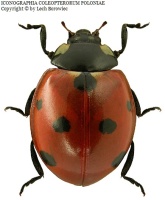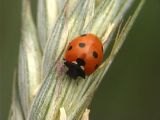
Русские, остановите эту войну! Спасите Свободную Украину!
Russians, stop this war! Save Free Ukraine!
Biodiversity Map
Taxa

Coccinella — subordinate taxa:
Taxon count: 6
-
Coccinella hieroglyphica hieroglyphicaSet as tree root ↑
Show taxon data → ⚑ [80] → Show taxon data
[80] → Show taxon data -
Coccinella magnificaSet as tree root ↑
Show taxon data → ⚑
 [102] → Show taxon data
[102] → Show taxon data -
Coccinella quinquepunctataSet as tree root ↑
Show taxon data → ⚑
 [115] → Show taxon data
[115] → Show taxon data -
Coccinella saucerottiiSet as tree root ↑
Show taxon data → ⚑ [7] → Show taxon data
[7] → Show taxon data -
Coccinella septempunctataSet as tree root ↑
Show taxon data → ⚑
 [354] → Show taxon data
[354] → Show taxon data -
Coccinella trifasciata trifasciataSet as tree root ↑
Show taxon data → [2] → Show taxon data
-
Arthropodaphylum
Click to switch
to select orders
and filters > -
Hexapodasubphylum
Click to switch
to select orders
and filters > -
Insectaclass
Click to switch
to select orders
and filters > -
Coleopteraorder
Click to set
as the main taxon
and as a base
← of the left panel > -
Polyphagasuborder
Click to set
as the main taxon
and as a base
← of the left panel > -
Cucujiformiaseries
Click to set
as the main taxon
and as a base
← of the left panel > -
Cucujoideasuperfamily
Click to set
as the main taxon
and as a base
← of the left panel > -
Coccinellidaefamily
Click to set
as the main taxon
and as a base
← of the left panel > -
Coccinellinaesubfamily
Click to set
as the main taxon
and as a base
← of the left panel > -
Coccinellinitribe
Click to set
as the main taxon
and as a base
← of the left panel > -
Coccinellagenus
Click to set
as the main taxon
and as a base
← of the left panel > -
Coccinellasubgenus
Click to set
as the main taxon
and as a base
← of the left panel >
PL
YES
name status: synonym
BioMap ID: 1019750
taxonomy checked: YES
valid name: Coccinella septempunctata
Data on distribution in Poland

Statistics
- Records: 354
- Publications: 24
- Collections: 13
- Publication authors: 31
- Illustrations (iconography): 1
- Photos (specimen/observation): 18
Taxon description
Szeroko rozpowszechniony gatunek w całej Palearktyce. Jest u nas jednym z najczęściej spotykanych gatunków biedronek. Występuje w najróżnorodniejszych średnio wilgotnych środowiskach. Zarówno postacie dojrzałe, jak i larwy, są bardzo drapieżne; napadają one i pożerają mszyce wielu gatunków żerujących na różnych roślinach. Zimuje na ziemi wśród zeschłych roślin i opadłego listowia.
Illustrations
... browse
 Coccinella
Coccinellaseptempunctata
Selected photos
... browse
 Coccinella
Coccinellaseptempunctata
 Coccinella
Coccinellaseptempunctata
 Coccinella
Coccinellaseptempunctata
 Coccinella
Coccinellaseptempunctata
 Coccinella
Coccinellaseptempunctata
 Coccinella
Coccinellaseptempunctata
 Coccinella
Coccinellaseptempunctata
 Coccinella
Coccinellaseptempunctata
External data sources
- Ostatnie rekordy
-
1140714
 ⊡
⊡ Coccinellidae: Coccinella septempunctata, PL, Pojezierze Pomorskie, ad Tuchola, UTM XV94, 1998 (Gutowski et al. 2005a)
Coccinellidae: Coccinella septempunctata, PL, Pojezierze Pomorskie, ad Tuchola, UTM XV94, 1998 (Gutowski et al. 2005a) -
1140713
 ⊡
⊡ Coccinellidae: Coccinella septempunctata, PL, Pojezierze Pomorskie, Pojezierze Południowopomorskie, Równina Charzykowska, P.N. Borów Tucholskich, pomorskie, Chojnice, Chojnice w., ad Bachorze, UTM XV66, 1998 (Gutowski et al. 2005a)
Coccinellidae: Coccinella septempunctata, PL, Pojezierze Pomorskie, Pojezierze Południowopomorskie, Równina Charzykowska, P.N. Borów Tucholskich, pomorskie, Chojnice, Chojnice w., ad Bachorze, UTM XV66, 1998 (Gutowski et al. 2005a) -
1140712
 ⊡
⊡ Coccinellidae: Coccinella septempunctata, PL, Pojezierze Pomorskie, Pojezierze Południowopomorskie, Bory Tucholskie, nadl. Osie, Wdecki P.K., kujawsko-pomorskie, Świecie, Osie, ad Osie, UTM CE24, 1998 (Gutowski et al. 2005a)
Coccinellidae: Coccinella septempunctata, PL, Pojezierze Pomorskie, Pojezierze Południowopomorskie, Bory Tucholskie, nadl. Osie, Wdecki P.K., kujawsko-pomorskie, Świecie, Osie, ad Osie, UTM CE24, 1998 (Gutowski et al. 2005a) -
1140711
 ⊡
⊡ Coccinellidae: Coccinella septempunctata, PL, Pojezierze Pomorskie, Pojezierze Południowopomorskie, Bory Tucholskie, Zaborski P.K., pomorskie, Chojnice, Brusy, ad Laska, UTM XV67, 1998 (Gutowski et al. 2005a)
Coccinellidae: Coccinella septempunctata, PL, Pojezierze Pomorskie, Pojezierze Południowopomorskie, Bory Tucholskie, Zaborski P.K., pomorskie, Chojnice, Brusy, ad Laska, UTM XV67, 1998 (Gutowski et al. 2005a) -
1140710
 ○
○ Coccinellidae: Coccinella septempunctata, PL, Bory Tucholskie, Pojezierze Pomorskie, UTM XV86 (Gutowski et al. 2005a)
Coccinellidae: Coccinella septempunctata, PL, Bory Tucholskie, Pojezierze Pomorskie, UTM XV86 (Gutowski et al. 2005a) -
1115637
 ⊡
⊡ Coccinellidae: Coccinella septempunctata, PL, Nizina Wielkopolsko-Kujawska, Pojezierze Lubuskie, Lubuski Przełom Odry, lubuskie, Słubice, Słubice, UTM VT79, 2020, leg. M. Adamski
Coccinellidae: Coccinella septempunctata, PL, Nizina Wielkopolsko-Kujawska, Pojezierze Lubuskie, Lubuski Przełom Odry, lubuskie, Słubice, Słubice, UTM VT79, 2020, leg. M. Adamski -
1115363
 ⊡
⊡ Coccinellidae: Coccinella septempunctata, PL, Wyżyna Krakowsko-Wieluńska, Brama Krakowska, Obniżenie Cholerzyńskie, małopolskie, Kraków m., Kraków, Bronowice, UTM DA14, 2020, leg. M. Syratt
Coccinellidae: Coccinella septempunctata, PL, Wyżyna Krakowsko-Wieluńska, Brama Krakowska, Obniżenie Cholerzyńskie, małopolskie, Kraków m., Kraków, Bronowice, UTM DA14, 2020, leg. M. Syratt -
1115032
 ⊡
⊡ Coccinellidae: Coccinella septempunctata, PL, Pojezierze Mazurskie, podlaskie, Grajewo, Wąsosz, UTM EE92, 2019, leg. K. Sućko
Coccinellidae: Coccinella septempunctata, PL, Pojezierze Mazurskie, podlaskie, Grajewo, Wąsosz, UTM EE92, 2019, leg. K. Sućko -
1112452
 ⊡
⊡ Coccinellidae: Coccinella septempunctata, PL, pobrzeże Bałtyku, Pobrzeże Bałtyku, Sarbinowo, UTM WA61, 2012, leg. J. Mazepa
Coccinellidae: Coccinella septempunctata, PL, pobrzeże Bałtyku, Pobrzeże Bałtyku, Sarbinowo, UTM WA61, 2012, leg. J. Mazepa -
1108300
 ⊡
⊡ Coccinellidae: Coccinella septempunctata, PL, Nizina Wielkopolsko-Kujawska, Wielkopolski P.N., Puszczykowo, UTM XT29, 1963 (Bogucki 1974)
Coccinellidae: Coccinella septempunctata, PL, Nizina Wielkopolsko-Kujawska, Wielkopolski P.N., Puszczykowo, UTM XT29, 1963 (Bogucki 1974) - ... more
- Powiązane publikacje
-
Ruta R., Melke A. 2011. Materiały do znajomości chrząszczy (Insecta: Coleoptera) rezerwatu przyrody „Kuźnik” koło Piły. Wiad. Entomol., 30(2):84-98.
 full text
full text Show records
Show records -
Jaworska-Krzymińska J. 2011. Biedronki ważnym czynnikiem ograniczającym populację mszyc w uprawie wierzby energetycznej. Prog. Plant Protection/Post. Ochr. Roślin., 51(3):1265-1268.
 Show records
Show records -
Byk A. 2011. Wpływ sposobu przygotowania gleby na zgrupowania chrząszczy (Coleoptera) występujace na uprawach leśnych założonych na gruntach porolnych. Sylwan, 155(9):622-632.
 Show records
Show records -
Bubienko K., Ciepielewska D. 2010. Ladybirds (Coleoptera, Coccinellidae) on the beaches of Gdańsk. Aphids and Other Hemipterous Insects, 16:119-125.
 Show records
Show records -
Bubienko K., Kosewska A., Ciepielewska D. 2010. Ladybirds (Coleoptera, Coccinellidae) of midfield thickets. Aphids and Other Hemipterous Insects, 16:107-117.
 Show records
Show records - ... more




